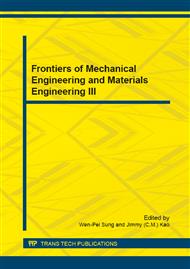p.318
p.322
p.327
p.331
p.335
p.339
p.345
p.349
p.354
Numerical Simulation of Metal Cutting Process Based on ANSYS/LS-DYNA
Abstract:
Cutting process is a typical non-linear deformation problem, which involves material non-linear, geometry non-linear and the state non-linear problem. Based on the elastic-plastic material deformation theory, this theme established a strain hardening model. Build the simulation model of two-dimensional orthogonal cutting process of workpiece and tool by the finite element method (FEM), and simulate the changes of cutting force and the process of chip formation in the machining process, and analyzed the cutting force, the situation of chip deformation. The method is more efficient and effective than the traditional one, and provides a new way for metal cutting theory, research of material cutting performance and cutting tool product development.
Info:
Periodical:
Pages:
335-338
Citation:
Online since:
January 2015
Authors:
Keywords:
Price:
Сopyright:
© 2015 Trans Tech Publications Ltd. All Rights Reserved
Share:
Citation:


